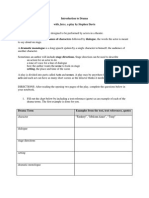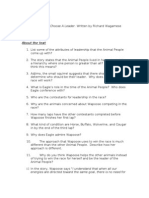0 ratings0% found this document useful (0 votes)
2K views6 Eng1d Ss Suspense Note
6 Eng1d Ss Suspense Note
Uploaded by
api-372183039Suspense is created through situations that cause anxious uncertainty or intellectual curiosity in the audience. There are two types of suspense - intellectual curiosity about a teaser situation, and emotional involvement where the audience experiences the same emotions as the characters in tense or dangerous situations. Authors use methods like conflicts, precarious situations, unsolvable problems, foreshadowing, delays, and red herrings to develop suspense in a story and keep the audience wondering about the outcome.
Copyright:
© All Rights Reserved
Available Formats
Download as DOC, PDF, TXT or read online from Scribd
6 Eng1d Ss Suspense Note
6 Eng1d Ss Suspense Note
Uploaded by
api-3721830390 ratings0% found this document useful (0 votes)
2K views1 pageSuspense is created through situations that cause anxious uncertainty or intellectual curiosity in the audience. There are two types of suspense - intellectual curiosity about a teaser situation, and emotional involvement where the audience experiences the same emotions as the characters in tense or dangerous situations. Authors use methods like conflicts, precarious situations, unsolvable problems, foreshadowing, delays, and red herrings to develop suspense in a story and keep the audience wondering about the outcome.
Original Title
6 eng1d ss suspense note
Copyright
© © All Rights Reserved
Available Formats
DOC, PDF, TXT or read online from Scribd
Share this document
Did you find this document useful?
Is this content inappropriate?
Suspense is created through situations that cause anxious uncertainty or intellectual curiosity in the audience. There are two types of suspense - intellectual curiosity about a teaser situation, and emotional involvement where the audience experiences the same emotions as the characters in tense or dangerous situations. Authors use methods like conflicts, precarious situations, unsolvable problems, foreshadowing, delays, and red herrings to develop suspense in a story and keep the audience wondering about the outcome.
Copyright:
© All Rights Reserved
Available Formats
Download as DOC, PDF, TXT or read online from Scribd
Download as doc, pdf, or txt
0 ratings0% found this document useful (0 votes)
2K views1 page6 Eng1d Ss Suspense Note
6 Eng1d Ss Suspense Note
Uploaded by
api-372183039Suspense is created through situations that cause anxious uncertainty or intellectual curiosity in the audience. There are two types of suspense - intellectual curiosity about a teaser situation, and emotional involvement where the audience experiences the same emotions as the characters in tense or dangerous situations. Authors use methods like conflicts, precarious situations, unsolvable problems, foreshadowing, delays, and red herrings to develop suspense in a story and keep the audience wondering about the outcome.
Copyright:
© All Rights Reserved
Available Formats
Download as DOC, PDF, TXT or read online from Scribd
Download as doc, pdf, or txt
You are on page 1of 1
SUSPENSE – A
DEFINITION
SUSPENSE is a quality – in a situation, incident or in a behaviour – that
causes anxious uncertainty.
In a well-planned story, the suspense keeps the audience wondering
about the outcome of the main character’ s conflict
Anxiety increases as the plot develops The plot of a story is like an
emotional rollercoaster. As you go up, and up, and up, the anxiety
increases until the climax is reached.
TYPES OF SUSPENSE
SUSPENSE can be divided into two types: one type provokes intellectual
curiosity; the other creates emotional involvement.
a) Intellectual Curiosity: Situations, behaviour or incidents that pose
an intellectual “teaser”
b) Emotional Involvement: A situation, incident, or a series of incidents
or behaviour that is so tense with feeling or imminent danger that
the audience , too, experiences the same emotions felt by the
character.
METHODS USED TO CREATE SUSPENSE
1. Conflict: The audience wonders how each conflict will end.
2. A precarious situation: How will the person get him or herself out?
3. An unsolvable problem: How can the person involved resolve it?
4. Foreshadowing: Hints that the author gives about actions and events
that will happen later in the story. The audience wonders if these will
happen and what effect they will have.
5. Delay: Postponing an anticipated event to keep the interest high.
6. Red Herrings: Clues that lead you off track.
You might also like
- Golden Pants StoryDocument4 pagesGolden Pants Storyapi-37218303950% (2)
- Annotation Guide For The AlchemistDocument2 pagesAnnotation Guide For The Alchemistapi-332791492No ratings yet
- Crucible UnitDocument3 pagesCrucible UnitJerad DampsonNo ratings yet
- DiggingDocument11 pagesDiggingMohammad AjajNo ratings yet
- Ela ReviewDocument3 pagesEla Reviewapi-329035384No ratings yet
- Shirley Jackson, "The Lottery" - Discussion and Analysis QuestionsDocument2 pagesShirley Jackson, "The Lottery" - Discussion and Analysis Questionsapi-37218303967% (3)
- Most Dangerous Game Anticipation GuideDocument1 pageMost Dangerous Game Anticipation Guideabscessmemory13No ratings yet
- 12 AP Lit Frankenstein Note-Taking GuideDocument20 pages12 AP Lit Frankenstein Note-Taking GuideMr. Ryan Costello100% (1)
- Lotf Survivor AnnotationsDocument2 pagesLotf Survivor Annotationsapi-263968986No ratings yet
- Gatsby Tic Tac Toe ProjectDocument3 pagesGatsby Tic Tac Toe Projectapi-21129271No ratings yet
- Introduction To DramaDocument2 pagesIntroduction To Dramaapi-260908902No ratings yet
- The Outsiders Final Exam: Multiple Choice: Circle The Answer That Correctly Answers The Question orDocument6 pagesThe Outsiders Final Exam: Multiple Choice: Circle The Answer That Correctly Answers The Question orSahire ArslanNo ratings yet
- 3 B Song Analysis Poetry AssignmentDocument3 pages3 B Song Analysis Poetry Assignmentapi-372183039No ratings yet
- 1 Eng1d Ss Introduction To Short Stories Filled in AdditionsDocument5 pages1 Eng1d Ss Introduction To Short Stories Filled in Additionsapi-372183039No ratings yet
- Rosa Parks Quiz AnswersDocument5 pagesRosa Parks Quiz Answersapi-372183039No ratings yet
- Jekyll & Hyde PresentationDocument23 pagesJekyll & Hyde Presentationapi-224849525No ratings yet
- Five Elements of The Short StoryDocument4 pagesFive Elements of The Short StoryLizaAnn100% (1)
- Louis Riel EssayDocument4 pagesLouis Riel EssayThomas LaiNo ratings yet
- N Be Short Story Animal PeopleDocument2 pagesN Be Short Story Animal PeopleJennifer LaChapelle100% (1)
- The Most Dangerous Game - Discussion QuestionsDocument2 pagesThe Most Dangerous Game - Discussion QuestionsWillNo ratings yet
- Lotf Vocabulary in ContextDocument6 pagesLotf Vocabulary in Contextapi-339060719No ratings yet
- Identifying Themes PDFDocument2 pagesIdentifying Themes PDFArianne Lee100% (1)
- Efp 12 Literature CirclesDocument2 pagesEfp 12 Literature Circlesapi-274019311No ratings yet
- Chapter Summary Template AdjustedDocument1 pageChapter Summary Template AdjustedLizz BakerNo ratings yet
- Oranges 2 PDFDocument2 pagesOranges 2 PDFSheni OgunmolaNo ratings yet
- 2 The Most Dangerous Game WsDocument3 pages2 The Most Dangerous Game Wsapi-233689989No ratings yet
- La - Literature - The Time Machine - Chapter 6Document6 pagesLa - Literature - The Time Machine - Chapter 6api-238179390No ratings yet
- Microsoft Word - A Sound of Thunder Reading QuestionsDocument2 pagesMicrosoft Word - A Sound of Thunder Reading QuestionsMedo O. EzzatNo ratings yet
- ActivityDocument1 pageActivityCJ100% (1)
- Tkamb ChoiceboardDocument1 pageTkamb Choiceboardapi-481778446No ratings yet
- The Old Man and The Sea: A Student Response Journal ForDocument6 pagesThe Old Man and The Sea: A Student Response Journal ForMã Văn TàiNo ratings yet
- Theme Mini LessonDocument11 pagesTheme Mini LessonseshollNo ratings yet
- Taming of The Shrew Unit PlanDocument10 pagesTaming of The Shrew Unit Planapi-652195726No ratings yet
- Author To Her Book by Anne Bradstreet LPDocument4 pagesAuthor To Her Book by Anne Bradstreet LPMorgan ReidNo ratings yet
- Lady and The Tiger Hand OutDocument2 pagesLady and The Tiger Hand OutchristinahyltonNo ratings yet
- Lotf Character Metaphor ProjectDocument5 pagesLotf Character Metaphor Projectapi-360391193No ratings yet
- The Crucible Rhetorical Scene Analysis AssignmentDocument4 pagesThe Crucible Rhetorical Scene Analysis Assignmentjune.babcockNo ratings yet
- The Pedestrian by Ray BradburyDocument3 pagesThe Pedestrian by Ray BradburyJojo RanuNo ratings yet
- The Most Dangerous Game QuestionsDocument3 pagesThe Most Dangerous Game QuestionsBethsua Elizeth Santos Flores100% (1)
- Poems, Songs & SpeechesDocument10 pagesPoems, Songs & SpeechesShiela Mae Cruz100% (1)
- Touching Spirit Bears - Krishiv Parikh - Period 4Document27 pagesTouching Spirit Bears - Krishiv Parikh - Period 4api-462515872No ratings yet
- Elements of Fiction NEWDocument33 pagesElements of Fiction NEWFlorencia GarciaNo ratings yet
- Catcher in The Rye - Study PackDocument8 pagesCatcher in The Rye - Study PackhaydnlucawhyteNo ratings yet
- VCE Argument Analysis Structure and Template Art of Smart EducationDocument4 pagesVCE Argument Analysis Structure and Template Art of Smart EducationBijila Biju JayakumariNo ratings yet
- Narrative HookDocument4 pagesNarrative Hookapi-262506169No ratings yet
- The Monkeys Paw Crossword PuzzleDocument1 pageThe Monkeys Paw Crossword Puzzleapi-372183039No ratings yet
- Where The Red Fern Grows Book ReportDocument2 pagesWhere The Red Fern Grows Book Reportapi-239501898No ratings yet
- La - Literature - The Time Machine - Chapter 4Document6 pagesLa - Literature - The Time Machine - Chapter 4api-238179390No ratings yet
- Secondary Unit Plan - Romeo and JulietDocument2 pagesSecondary Unit Plan - Romeo and Julietapi-240694323No ratings yet
- Written Task One and Two For Part 3Document2 pagesWritten Task One and Two For Part 3floramather0% (2)
- Curriculum Pacing GuideEnglish KG1Document5 pagesCurriculum Pacing GuideEnglish KG1princess27SNo ratings yet
- Spend A Day in My Shoes Lesson PlanDocument4 pagesSpend A Day in My Shoes Lesson PlanKimNo ratings yet
- A Sound of Thunder - Reading Response ADocument3 pagesA Sound of Thunder - Reading Response AAhsan HomarNo ratings yet
- Outsiders Figurative Language WorksheetDocument2 pagesOutsiders Figurative Language WorksheetAlyssia MutchersonNo ratings yet
- One Novel Literature CirclesDocument17 pagesOne Novel Literature Circlesapi-221379222No ratings yet
- Poetry Unit 2Document7 pagesPoetry Unit 2Vian100% (1)
- The Lady, or The TigerDocument8 pagesThe Lady, or The TigerDaniel FrazónNo ratings yet
- Raisin in The Sun Act 1, Scene 1Document2 pagesRaisin in The Sun Act 1, Scene 1Lori Tolar100% (1)
- Necklace QuestionsDocument2 pagesNecklace QuestionsMatiuillah AhmadiNo ratings yet
- Ap OmamDocument8 pagesAp OmamAnna Royal100% (1)
- Character Archetypes 2021 PPTX PresentationDocument33 pagesCharacter Archetypes 2021 PPTX PresentationTracy PattersonNo ratings yet
- Questions For Discussion The GiverDocument1 pageQuestions For Discussion The GiverLuke ShimNo ratings yet
- COMM 101: Fundamentals of Public Speaking - Ms. Wilde: Course DescriptionDocument5 pagesCOMM 101: Fundamentals of Public Speaking - Ms. Wilde: Course DescriptionPierce HerbertNo ratings yet
- A Study Guide for John Keats's "When I Have Fears That I May Cease to Be"From EverandA Study Guide for John Keats's "When I Have Fears That I May Cease to Be"No ratings yet
- Atdpti Chapter Study Sheet CH 4 PDFDocument3 pagesAtdpti Chapter Study Sheet CH 4 PDFapi-372183039No ratings yet
- Atdpti Chapter Study Sheet CH 2 PDFDocument3 pagesAtdpti Chapter Study Sheet CH 2 PDFapi-372183039No ratings yet
- 21 1d Ss Priscilla and The Wimps Questions-4Document2 pages21 1d Ss Priscilla and The Wimps Questions-4api-372183039No ratings yet
- Atdpti Chapter Study Sheet CH 1 PDFDocument3 pagesAtdpti Chapter Study Sheet CH 1 PDFapi-372183039No ratings yet
- TrumanshowdiscussionquestionsDocument2 pagesTrumanshowdiscussionquestionsapi-372183039No ratings yet
- Legalized MarijuanaDocument4 pagesLegalized Marijuanaapi-372183039No ratings yet
- Team Building ActivitiesDocument70 pagesTeam Building Activitiesapi-372183039100% (1)
- Bang Bang Youre Dead QuestionsDocument2 pagesBang Bang Youre Dead Questionsapi-372183039No ratings yet
- Golden Pants VocabularyDocument8 pagesGolden Pants Vocabularyapi-372183039No ratings yet
- The Monkeys PawDocument7 pagesThe Monkeys Pawapi-372183039No ratings yet
- The Monkeys Paw Alternative Ending Writing ActivityDocument2 pagesThe Monkeys Paw Alternative Ending Writing Activityapi-372183039No ratings yet
- Basic Story Writing Template - NameDocument1 pageBasic Story Writing Template - Nameapi-372183039No ratings yet
- 7 B The Most Dangerous Game 24 QuestionsDocument2 pages7 B The Most Dangerous Game 24 Questionsapi-372183039No ratings yet
- Miss Representation Educators SupplementDocument83 pagesMiss Representation Educators Supplementapi-372183039No ratings yet
- Miss Representation Educators SupplementDocument83 pagesMiss Representation Educators Supplementapi-372183039No ratings yet
- Authors PurposeDocument5 pagesAuthors Purposeapi-372183039No ratings yet
- Miss Representation DGDocument4 pagesMiss Representation DGapi-372183039No ratings yet
- 5 Eng1d Ss Literary DevicesDocument2 pages5 Eng1d Ss Literary Devicesapi-372183039No ratings yet
- To Build A Fire Reading QuestionsDocument1 pageTo Build A Fire Reading Questionsapi-372183039No ratings yet
- On The Sidewalk BleedingDocument5 pagesOn The Sidewalk Bleedingapi-372183039No ratings yet
- Female Leadership Bloom Ball AssignmentDocument13 pagesFemale Leadership Bloom Ball Assignmentapi-372183039No ratings yet
- 2 Eng1d Ss Characterization Note Filled inDocument5 pages2 Eng1d Ss Characterization Note Filled inapi-372183039No ratings yet
- Poetry Response WorksheetDocument3 pagesPoetry Response Worksheetapi-372183039No ratings yet
- On The Sidewalk Bleeding Article Assignment 1rigo9dDocument3 pagesOn The Sidewalk Bleeding Article Assignment 1rigo9dapi-372183039No ratings yet
- What Is News 2Document6 pagesWhat Is News 2api-372183039No ratings yet
























































































